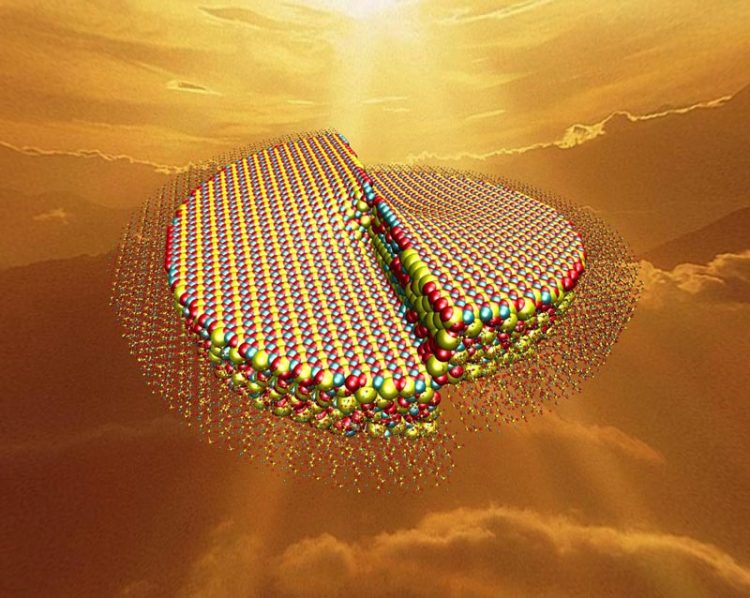Crush those clinkers while they're hot

A cutaway illustration of a clinker, a pellet manufactured in a kiln and then ground to make cement, shows a defect called a screw dislocation. Rice University scientists studied the effect of such defects on the quality of cement used in concrete and how much energy could be saved by modifying the manufacturing process. Credit: Shahsavari Group/Rice University
Making cement is a centuries-old art that has yet to be perfected, according to researchers at Rice University who believe it can be still more efficient.
Former Rice graduate student Lu Chen and materials scientist Rouzbeh Shahsavari calculated that fine-tuning the process by which round lumps of calcium silicate called clinkers are turned into cement can save a lot of energy. Their new findings are detailed in the American Chemical Society journal Applied Materials and Interfaces.
Manufacturers of Portland cement, the most common type in use around the world, make clinkers by heating raw elements in a rotary kiln and grinding them into the fine powder that becomes cement. Mixed with water, cement becomes the glue that holds concrete together. An earlier study by Shahsavari and his colleagues that viewed the molecular structure of cement noted that worldwide, concrete manufacturing is responsible for 5 to 10 percent of the carbon dioxide, a greenhouse gas, released into the atmosphere.
The researchers analyzed the crystal and atomic structures of five phases of clinkers representing stages of cooling after they leave the kiln. They focused on the internal stresses that make some more brittle (and easier to grind) than others. They also looked at the unavoidable defects called screw dislocations, shear offsets in the raw materials that, even when ground, influence how well the powders mix with water. That reactivity determines the cement's ultimate strength.
They found that clinkers were not only most brittle when hottest, but also the most reactive. In ranking the five samples' qualities, they suggested their research could lead manufacturers to consolidate processes and cut grinding energy that now absorbs around 10-12 percent of the energy required to make cement. Equally important, for each ton of produced cement, the grinding energy accounts for roughly 50 kilograms of carbon dioxide emissions into the atmosphere, they determined.
“Defects form naturally, and you cannot do anything about them,” Shahsavari said. “But the more brittle the clinkers are, the better they are for grinding. We found that the initial phase out of the kiln is the most brittle and that defects carry through to the powder. These are places where water molecules want to react.”
###
The National Science Foundation supported the research. Shahsavari is an assistant professor of civil and environmental engineering and of materials science and nanoengineering and a member of the Richard E. Smalley Institute for Nanoscale Science and Technology at Rice. Chen is now a structural engineer at Arup.
Read the abstract at http://pubs.
This news release can be found online at http://news.
Follow Rice News and Media Relations via Twitter @RiceUNews
Related Materials
Shahsavari Group: http://rouzbeh.
George R. Brown School of Engineering: http://engineering.
Images for download: http://news.
Located on a 300-acre forested campus in Houston, Rice University is consistently ranked among the nation's top 20 universities by U.S. News & World Report. Rice has highly respected schools of Architecture, Business, Continuing Studies, Engineering, Humanities, Music, Natural Sciences and Social Sciences and is home to the Baker Institute for Public Policy. With 3,920 undergraduates and 2,567 graduate students, Rice's undergraduate student-to-faculty ratio is just over 6-to-1. Its residential college system builds close-knit communities and lifelong friendships, just one reason why Rice is highly ranked for best quality of life by the Princeton Review and for best value among private universities by Kiplinger's Personal Finance.
Media Contact
All latest news from the category: Materials Sciences
Materials management deals with the research, development, manufacturing and processing of raw and industrial materials. Key aspects here are biological and medical issues, which play an increasingly important role in this field.
innovations-report offers in-depth articles related to the development and application of materials and the structure and properties of new materials.
Newest articles

Recovering phosphorus from sewage sludge ash
Chemical and heat treatment of sewage sludge can recover phosphorus in a process that could help address the problem of diminishing supplies of phosphorus ores. Valuable supplies of phosphorus could…

Efficient, sustainable and cost-effective hybrid energy storage system for modern power grids
EU project HyFlow: Over three years of research, the consortium of the EU project HyFlow has successfully developed a highly efficient, sustainable, and cost-effective hybrid energy storage system (HESS) that…

After 25 years, researchers uncover genetic cause of rare neurological disease
Some families call it a trial of faith. Others just call it a curse. The progressive neurological disease known as spinocerebellar ataxia 4 (SCA4) is a rare condition, but its…





















